A Private Tour today, down in the Brecks. The weather forecast for today wasn’t great – cold & cloudy, but with the possibility of some brighter intervals. At least it wasn’t meant to be as bad as the last couple of days, which have been rather foggy and bitterly cold.
The real target for the day was Goshawk. These secretive birds are best looked for early in the year on bright sunny days, when they display above the trees. Needless to say, it was not the best day to look for them weather-wise. However, we were more enthusiastic about our prospects as the sun burnt off the mist as we drove down to the Brecks. For a time, it was sunny and blue sky.
We parked at a regular spot and set off in search of raptors. As we scanned the trees, there seemed to be a good number of Common Buzzards up already, five circling together at one point. A Red Kite drifted over lazily, hanging in the air. As it circled back over the trees, it had a go at a pale Common Buzzard perched in the top of a pine, knocking it off its perch. It all felt quite promising, with the low sun just starting to warm the air a fraction after last night’s frost. But then the mist rolled back in and the temperature dropped again. That wasn’t what the forecast had promised us! There were still Common Buzzards to be seen at times, but raptor activity dropped again noticeably.
There was still the chance that a Goshawk might fly out of the trees, so we waited a while, hoping the weather might improve again. There were other birds to be seen. With the sound of gunfire on the horizon, the Pheasants were hiding around the game cover and a covey of Red-legged Partridges went running along the edge looking for cover. Just a few days more now, and they might have survived the shooting season for this year. Three Yellowhammers flew up from the maize and circled over calling. A Skylark flew past and a Fieldfare and a Mistle Thrush both flew over.
A phone call from a friendly local gave us an alternative target to pursue, so we decided to take a break from looking for raptors. A short drive and we were looking at a Glaucous Gull standing in a field. It was a juvenile, with pale biscuit coloured body, distinctive pale wing tips, and a very striking large bill, pink-based with a ‘dipped in ink’ black tip.
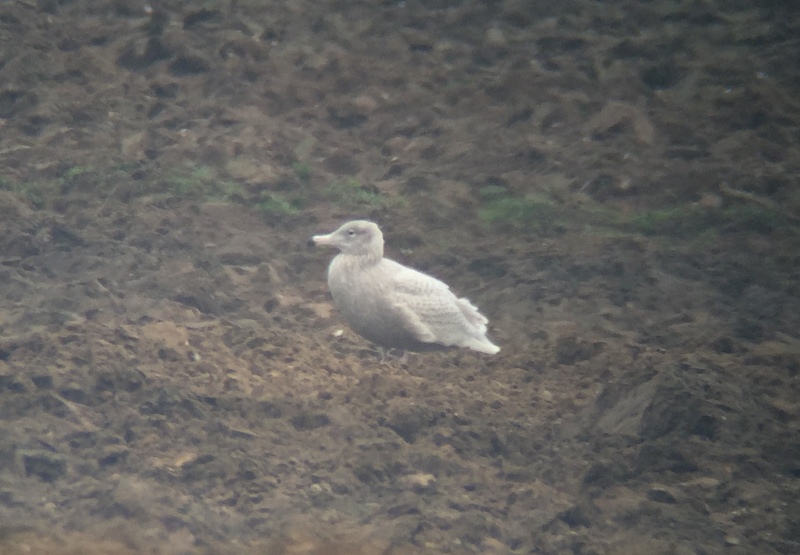 Glaucous Gull – a juvenile with pale wing tips and distinctive bill
Glaucous Gull – a juvenile with pale wing tips and distinctive bill
There were lots of other gulls loafing around on the other side of the ploughed field – mainly Common Gulls and Black-headed Gulls, plus a handful of Herring Gulls and a single Lesser Black-backed Gull. Apparently, the Glaucous Gull had earlier been in the middle of them, but it had now flown out into the middle of the ploughed field and was picking around among the furrows on its own.
After looking at the gulls, we resumed our search for a Goshawk but decided on a change of tactic. Rather than wait for one to come out of the trees, we thought we might walk through the forest in an area where we have come across feeding birds before. It was an outside chance, but it was worth a go. We drove round to another secluded part of the forest, but when we got there, we found a car parked at the head of the ride. A couple were already walking down the track, with a couple of dogs. If there were to be a Goshawk hiding in the forest here, it was clear that they would flush it before we got to it. Time for plan C!
Back in the car, and we set off again. We hadn’t gone very far when we looked across at the edge of the trees and saw a large bird circling just above the tops. Presumably just another Buzzard? No, a Goshawk! We pulled up and got out of the car, just in time to see it circle up a little higher and then drop back over the trees and disappear from view. It was a brief view but we had finally managed to find a Goshawk out in the mist.
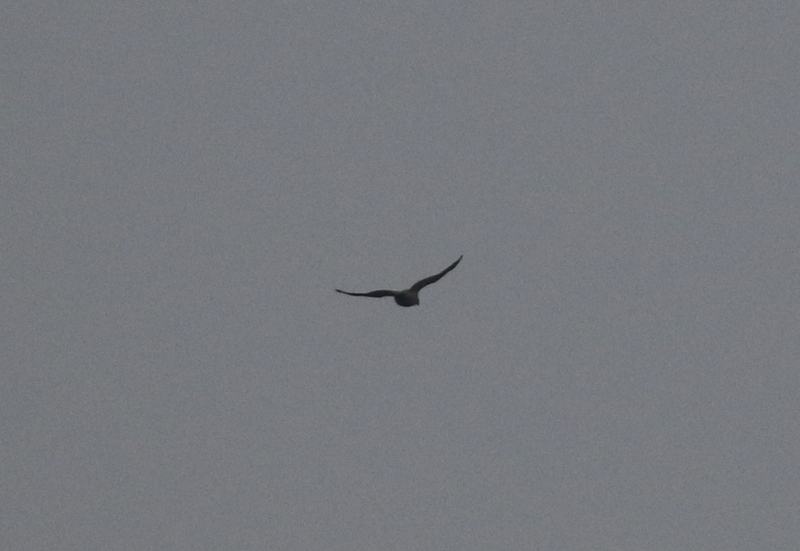 Goshawk – disappearing away over the trees
Goshawk – disappearing away over the trees
Presumably the Goshawk had been flushed out of the trees by the couple walking their dogs. If we had followed them, we certainly wouldn’t have seen it at all. It looked like a young bird – rather dark brownish above.
The weather seemed to be improving a little, so we decided to try one more site to see if we could improve on the views we had just had. We parked by another ride and walked into the forest. After a while, we came to a clearing. A female Stonechat flew ahead of us, and joined up with another pair of Stonechats, the three of them feeding in the grass, perching up on the taller dead seedheads and then dropping down to the ground. We flushed a couple of flocks of Meadow Pipits out of the grass too, as we passed. A Mistle Thrush perched in the top of a holly tree, laden with berries, presumably looking to defend it against anyone else looking to try to feed on them. We scanned the trees all around – a Common Buzzard flew over the tops and several Carrion Crows too, but we couldn’t see anything else.
Around the other side of the clearing, we noticed a very small mammal dead on the path. It was a Pygmy Shrew. It looked like it had been caught and then dropped by something – it had a spot of blood on its belly but otherwise looked untouched. It wouldn’t have made much of a meal!
 Pygmy Shrew – dead on the path
Pygmy Shrew – dead on the path
As we made our way back to the car, a flock of tits came along the line of deciduous trees by the road. They were mainly Long-tailed Tits that we could see at first, but we heard a Treecreeper calling and looked up into a nearby pine to see a Goldcrest flitting around in the needles. A Marsh Tit started calling and flew across the track and into a beech tree. Then a pair of Nuthatches flew across the road and into the top of a tree the other side, where we could see them climbing up and down.
Our next destination was the picnic area at St Helens. This is a great spot for Bramblings and we were not disappointed. As soon as we pulled into the car park, we saw loads of them flying up from the leaves under the beech trees along the edge. We got out and had a walk round. We managed to find a couple of Bramblings perched in the trees, but they were very mobile at first. Eventually, when we walked back to the car, we found they were all feeding over in that corner. Through the scope, we could see about fifteen on the ground all together, but when they were spooked by something, at least sixty Bramblings flew up into the trees. There were a smaller number of Chaffinches with them too.
 Brambling – a male at St Helens, photographed yesterday
Brambling – a male at St Helens, photographed yesterday
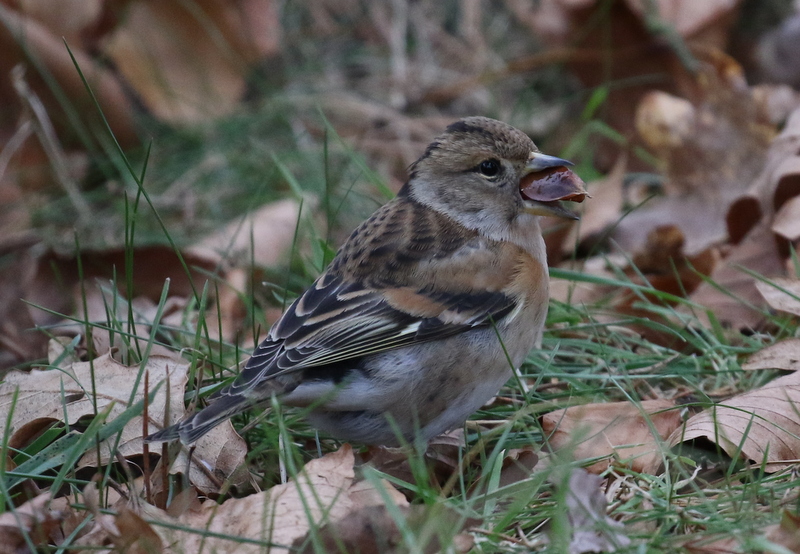 Brambling – a duller, greyer faced female
Brambling – a duller, greyer faced female
There were lots of nice smart males amongst the Bramblings, with brighter orange breast and shoulders. There was quite a bit of variation though, with some having blacker faces but many still much paler. The black head and upperparts of the male Brambling is obscured by pale feather fringes which gradually wear off during the winter, at different rates in different individuals.
Finally, the sun appeared again and we could see pockets of blue sky overhead once more. It was already lunchtime, so we stopped for a bite to eat in the sunshine. While we were there, two Common Crossbills flew over calling. They appeared to drop down towards the trees by the river but once we had walked round to where we could view them, there was no sign of the birds.
After lunch, we drove over to Lynford Arboretum. The feeders looked largely empty today and there was a tractor working noisily nearby, so we carried on down the track to the bridge. As we approached, we could hear Crossbills calling and looked down ahead of us to see a pair come out of the trees and disappear off towards the paddocks.
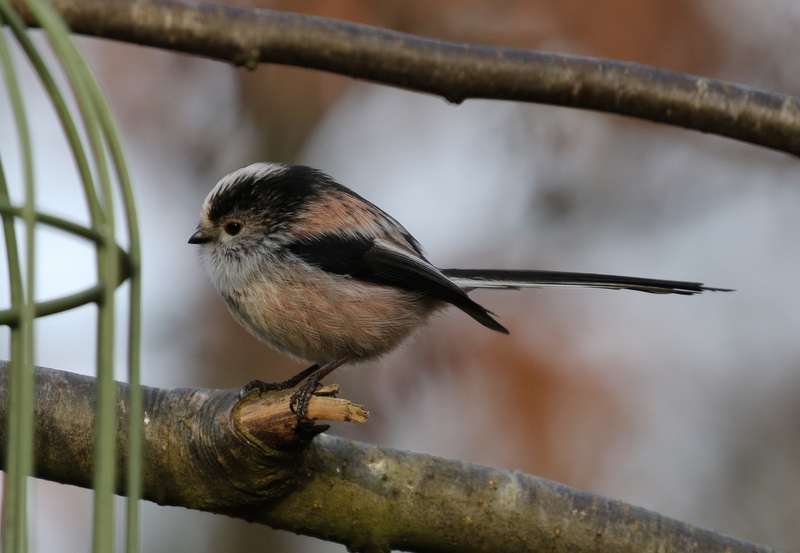 Long-tailed Tit – coming to the feeder above the bridge
Long-tailed Tit – coming to the feeder above the bridge
When we got down to the bridge, there wasn’t any food out here either today, part from one feeder. There were plenty of birds though. There were lots of tits – Blue Tits, Great Tits, Long-tailed Tits and a Coal Tit – coming down to the feeder hanging over the bridge. Other birds were flying down to look around the pillars, where more food is usually put out for them. A Marsh Tit or two came in for a look. A Reed Bunting did the same.
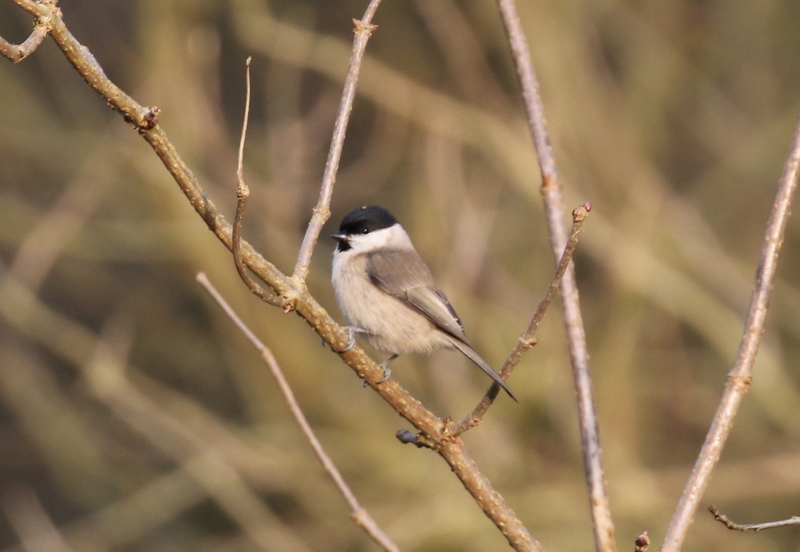 Marsh Tit – came in to look for food at the bridge
Marsh Tit – came in to look for food at the bridge
There were lots of Siskins in the trees, we could hear their constant chattering calls. Most of them were in the tops of the poplars, but one or two came down to drink lower down.
As we started to walk towards the paddocks, we heard a Common Crossbill call and turned round just in time to see it land in the top of the poplars briefly, before dropping down into the trees. Presumably it too had come in to drink. It was no more than a glimpse though. Thankfully, we were finally rewarded with better views when another pair of Crossbills flew in calling and landed in the poplars. These two remained there for some time, allowing us to get them in the scope. We could see their distinctive crossed mandible tips, an orange/red male and a green/yellow female.
 Common Crossbill – finally a pair landed so we could get them in the scope
Common Crossbill – finally a pair landed so we could get them in the scope
It was already Hawfinch time now, so we hurried down along the paddocks. There have been some very large numbers here in recent weeks, unprecedented in recent years. High counts of 60-80 have been recorded (last night, there were at least 40). The birds fly in late in the day to gather in the trees. From the side of the paddock, we could see at least eight Hawfinches already in the tops of the pines. We got them in the scope, but they were a bit distant from here.
We made our way round to the other side. We wouldn’t be able to count them from here, but we hoped for a better view. We were not disappointed! Over the next half an hour, we had a succession of Hawfinches perched up in the tops of the trees. First a rather pale, grey-brown female. Then a very smart male Hawfinch. Then a group of five in the same tree together, which were promptly joined by two more. It was a real Hawfinch-fest! We got them in the scope, admiring their massive bills, surrounded with black bib and face mask. At one point, the birds in the trees nearest to us flew up and we could see at least twenty all in the air together. Great stuff!
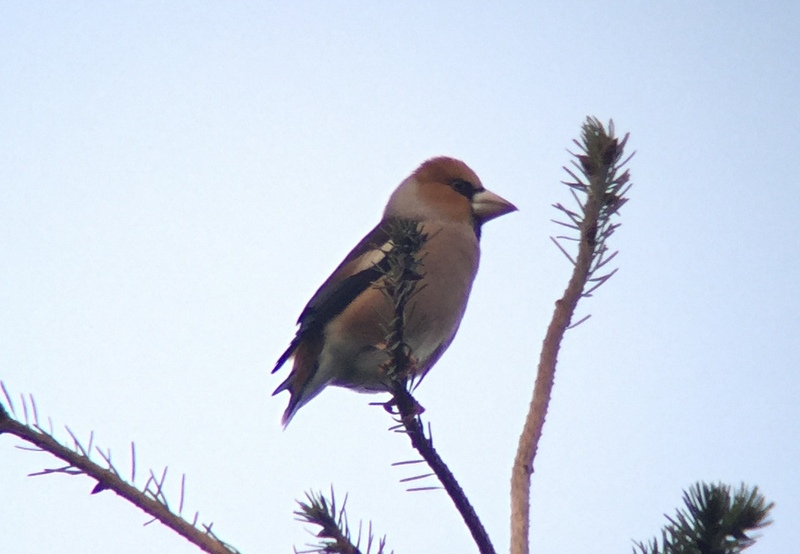 Hawfinch – lots around this afternoon & great views
Hawfinch – lots around this afternoon & great views
Eventually the Hawfinches nearest us started to drop down into the trees. We started to make our way back, round the paddocks. Looking across, we could still see at least twelve Hawfinches still in the tops of the pines, including eight together. These were in a different section of the trees to where we had been able to see earlier, so were probably different birds. Who know how many Hawfinches there were there this afternoon? Certainly a lot! It was quite a treat to see so many.
Delighted with the performance from the Hawfinches, we made our way back to the car park. We had a quick look at the gravel pits the other side of the road, but they were still mostly frozen. A few Mute Swans stood around on the ice and a melee of Gadwall and Tufted Ducks were packed into the small area of open water. Then it was time to call it a day and head for home. Despite the beat efforts of the weather, we had enjoyed a very successful day in the Brecks.
















